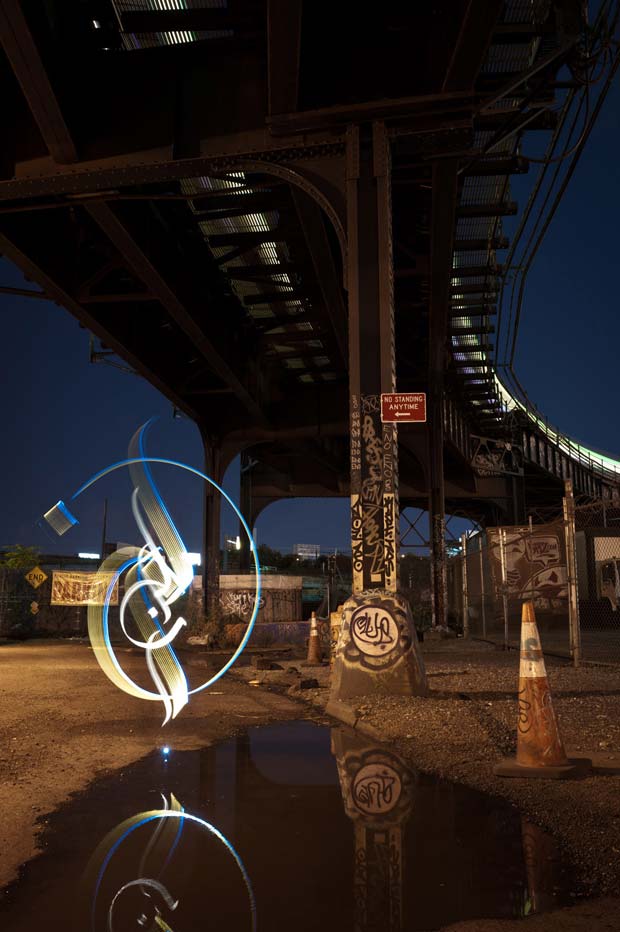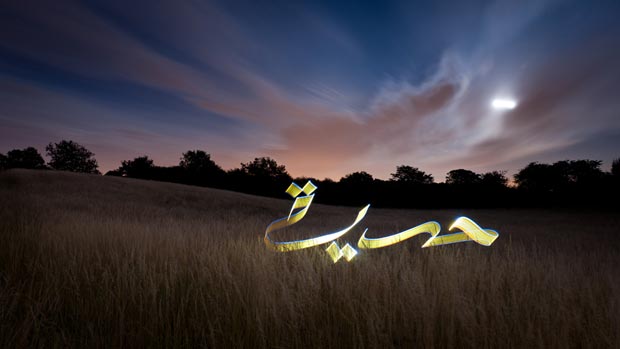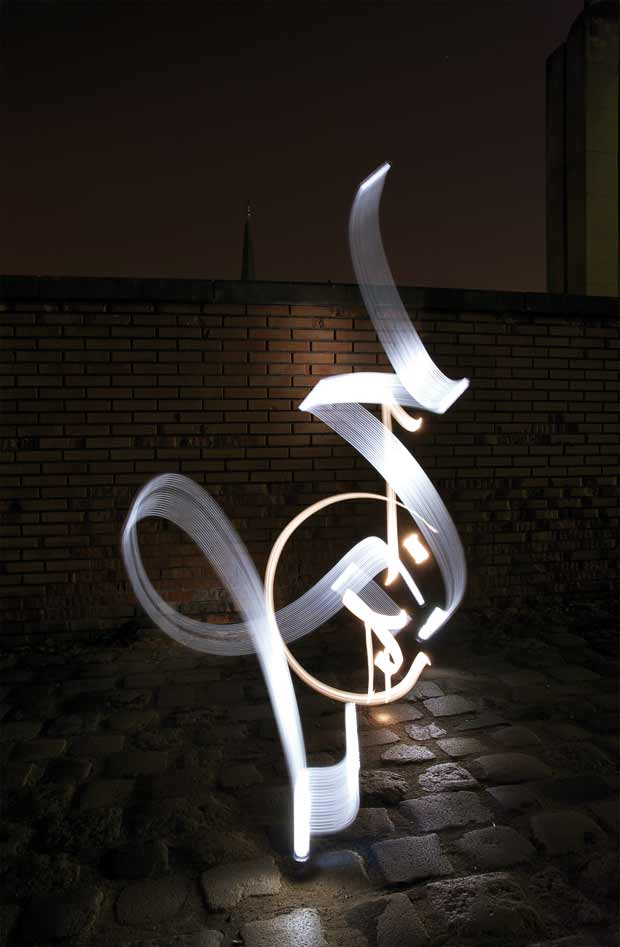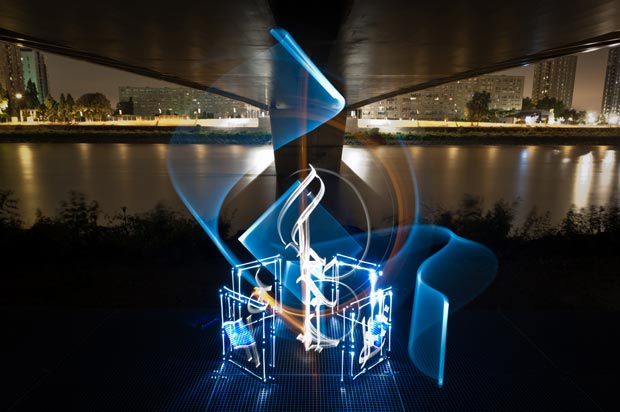
An Interview with a French artist Julien Breton Scripting Calligraphy with Light
Jul 17, 2012 Interview

Julien Breton also known as Kalaam is a French artist based in Nantes. Influenced by the street art tradition of graffiti, his work came to be inspired by Islamic calligraphy upon encountering the art of contemporary calligraphic master Hassan Massoudy in 2001. After designing Latin alphabet scripts that resemble Arabic and working on paper, he received another aesthetic shock upon discovering light calligraphy in 2006. Turning to calligraphic light painting, his performances are garnering increasing attention worldwide. The strength of his work resides in its breaking down of barriers between high and popular art, between media —his art encompasses movement, light, photography and script—, and between East and West as despite its evident indebtedness to Islamic calligraphy, it also integrates Western and East Asian elements.
 Julien Breton / Photo by Davide DiTria / Courtesy of Julien Breton
Julien Breton / Photo by Davide DiTria / Courtesy of Julien Breton
Effectively, these last three years have been an incredible journey that have given me the opportunity to realise various performances and exhibitions in different parts of the world. It gave me the chance to visit many places such as Abu Dhabi, Brussels, Milan and Tunisia whereas, not coming from a rich family, I had never previously travelled before. Calligraphy has thus taken me around the world.
The encounters they provoke necessarily influence my work. I already had a notion of human universality —my work is centred on the possibilities of the meeting between the Western and Muslim world— and the people I have met regardless of where have confirmed my vision that inscribed behind every culture are wider notions of humanism and a shared humanity.
 Julien Breton / Razy IMP / Courtesy of Julien Breton
Julien Breton / Razy IMP / Courtesy of Julien Breton
I am influenced or have been influenced by graffiti art but contrary to what is sometimes said, I never actually engaged in it. Light calligraphy is such a special and unique process. It takes place in the dark and outside and thus unlike traditional calligraphy it takes you out of the studio. When working on paper there is a limit in terms of size but also involvement. With light calligraphy, the scale is limitless and the practice involves the whole body. Like a choreography, it requires numerous repetitions because in a performance there can be no false move or hesitation. This said I work out my designs on paper first.
It is both instinctive and conscious. Instinctive because it is my identity. I am bicultural in that while I am a westerner of European descent, I grew up in a predominantly Arab neighbourhood of the city of Nantes where I was in fact steeped in Arab-Muslim culture. I am also very drawn to East Asian culture. Light calligraphy resembles Chinese and Japanese calligraphy in so many ways. It is an art of the instant and a lot of preparation and practice goes in to the experience of getting a line right. There is no room for error or redoing. The performance side of it is effectively like tai chi. I am very conscious of my centre of gravity, of balance and so on. It is like a martial art. However to get back to the question, it is also conscious because I desire to communicate with others and set out to cross barriers. This explains why when I meet and speak with someone from another culture, say for example Saudi Arabia, who is moved by my work it means so much to me.
 Julien Breton / Dead's place / Courtesy of Julien Breton
Julien Breton / Dead's place / Courtesy of Julien Breton
It is difficult to put into words because the relationship between the two is so deep. The phrases, verses or sayings that I select for my calligraphy all reflect my own philosophy of life whether they come from European philosophers, Arab poets or rap music. And their meaning clearly influences my work. The process of realizing light calligraphy involves hours of practice and like any performance artist, I repeat and rehearse, repeat and rehearse the piece hundreds of time during which time I concentrate not only on form but also on completely appropriating and integrating the meaning of the text which then becomes internalized. This means that each time the aesthetic of the work is influenced by the content. It is the text that leads me through the aesthetic paths of calligraphy.
We accomplished an enormous amount of creative work in the streets of NYC which was received in a wide variety of ways from “that’s really cool†to “what’s this guy doing out on the street in the middle of the night� I also did a commissioned performance recorded in front of the United Nations headquarters spelling the word freedom in Farsi for an NGO called Where is my Vote? I was also supposed to take part in a ‘Nuit Blanche’ event but this was cancelled at the last minute.
 Julien Breton / Freedom / Courtesy of Julien Breton
Julien Breton / Freedom / Courtesy of Julien Breton
Yes, it’s funny, I see myself as a researcher. I love and am always delighted to find new media to integrate into calligraphy or with which to practise it. For example, I invented a technology permitting the creation of virtual calligraphy in real time. Here rather than in light calligraphy where the spectator has to wait until the end of the performance to actually see the calligraphy, he or she can witness its construction in real time projected large scale unto a building for example. To answer your question, yes I am going to continue to integrate other performing arts to a greater extent. I am presently working on a show that encompasses music and dance, well two shows in fact: the one that already exists integrates the hip hop dance tradition while the future one on which I am presently working is more complex. The theme is the meeting of East and West and the show will feature an Arab hip hop dancer and a French contemporary dancer of European descent. The music will also be diverse including Arab music but also Western classical music. In this show, there is almost a storyline as in theatre.
There are two principal reasons. One is that I fell completely in love with Arabic writing when I first encountered it. A friend of mine had given me as a present a book on the famous France-based calligraphy Hassan Massoudy. I had never seen anything like it. I was mesmerized by the beauty and sensuality of the line. The art was both ethereal and rigorous and covered a whole spectrum of aesthetics from Kufic to diwani. However, at no time did I want to learn a particular script. Instead, I wanted to invent my own.
 Julien Breton / Liberte / Courtesy of Julien Breton
Julien Breton / Liberte / Courtesy of Julien Breton
I am a real perfectionist and am very rigorous. I have a precise vision for each piece and spend countless hours rehearsing, experimenting and executing until I get it just right. For example, I might be happy with the qualities of the script but not with the colour or the thickness of line and so redo it as many times necessary until I am satisifed.
Maybe or maybe not. I now have a four month old baby girl and therefore want to more spend time with my family. It also depends on what projects are offered to me. I nonetheless have several projects lined up, some in France, some in Belgium —for example an upcoming Muslim intercultural event— as well as one in England. I am mostly concentrating as I mentioned earlier on my two shows integrating dance.
 Julien Breton / Underthecity / Courtesy of Julien Breton
Julien Breton / Underthecity / Courtesy of Julien Breton
Thanks and I will of course keep IAM informed.
Comments
Add a comment